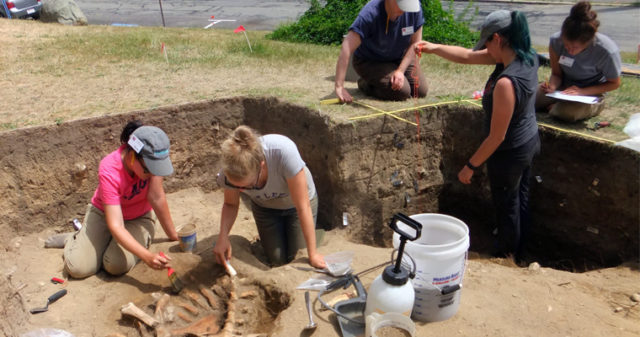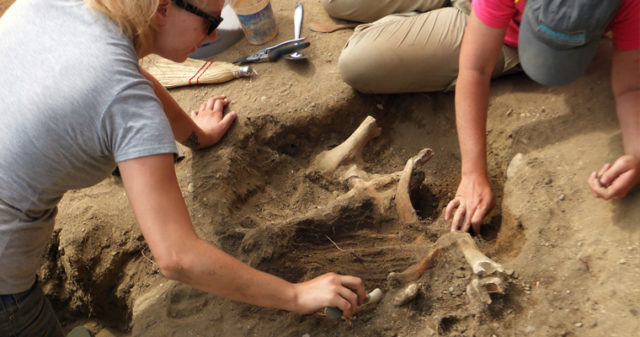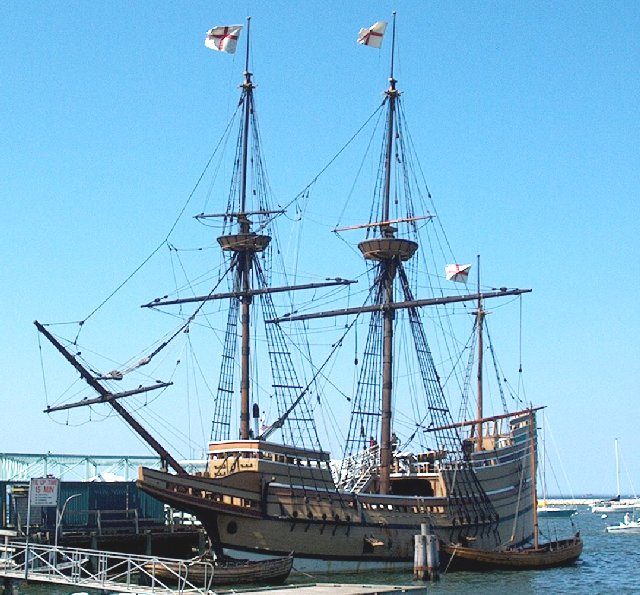Archaeologists digging up the past at the famous Burial Hill Cemetery in Massachusetts, USA, have made a breakthrough. They claim to have located the exact site of the first settlement of the Pilgrims. The aim was to find the exact location within the settlement walls and to do it by 2020 to coincide with the 400th centenary of the Pilgrims’ landing in New England. It seems that the team has accomplished the task with four years to spare.
The iconic and historic cemetery has long been located and is well known. The fort and, later, a cemetery is part of the National Register of Historic places and is said to contain the graves of the first pilgrims. The team has found the skeletal remains of a calf – definitive evidence of the settlement according to University of Massachusetts Boston’s Andrew Fiske Memorial Center for Archaeology.

The team from the university, led by David Landon, senior associate at the University, went for the fourth time to Burial Hill this summer. His team consists of undergraduate and graduate students; they stated that they had found many interesting finds at the site. It’s not only about finding interesting artifacts but also about interpreting what they find as they excavate, Landon added. Once the process begins, it’s a slow process, as they had to analyze what was there before, since it no longer exists.
The task at hand is slow and requires dedication. As the team excavated and interpreted the soil for signs of construction, what they were looking for were indications of construction, like holes for timber and dirt.
With the evidence of Constance the Calf, researchers are confident that this was the exact location of the first settlement some 400 years ago. Cattle was a major part of the Pilgrim economy, as the natives who inherited the land had no domesticated cattle. The team unearthed the calf that they affectionately named Constance. What led to the discovery of Constance was other such findings dating from the 17th century such as pottery, tins, trade beads, and musket balls. This led the team to believe that they were close, and once they reached the bottom of the pit, there was Constance.
The impact of the find has the potential to change the view and understanding of these early European settlers, to provide accurate information on the ancient settlers that first arrived in New England. This goes a long way in deciphering the past in order to allow a better re-creation and recounting of these brave men and women. The project received funding of $200,000 through the National Endowment for the Humanities (NEH).

The pilgrims set sail from Plymouth, England, September 1620, on the ship named the Mayflower. The pilgrims were escaping persecution from the King and the Church of England. It is estimated that there were 102 people aboard the ship, including 30 crew members.
Initially, the group meant to settle in what is modern day New York at the mouth of the Hudson River, however, they ended up on the coast of Cape Cod. The trip was meant to last a month – but due to unexpected delays such as bad weather, poor wind conditions, and damage to the Mayflower, they landed on 11th November 1620 after a voyage of 66 days. The trip across the ocean was trying on the passengers and crew, and one person died before the end of the voyage. The pilgrims and crew were also afflicted with a disease and sea sickness.
The weather conditions prevented the ship from traveling further north and the requirement for supplies forced the crew to anchor off the coast of Cape Cod and to send a team to find supplies and a suitable place to settle.
At the time of their arrival, it was winter and the conditions were severe. Due in part to the bad weather and shortage of supplies, there was urgent need to find suitable land for a settlement. It is at this time that the adult males of the ship signed the treaty which is known as the “Mayflower Compact”. The area where the Mayflower set anchor became known as Provincetown Harbor.

The land expiation was undertaken by the ablest of the group. During this time, disease and sickness took hold of the passengers left behind. It was on December 16th that the expedition founded what is now known as Plymouth Town. Although there was enough food, the dietary requirements were not met, and most of the pilgrims were malnourished. During the land expedition, a few skirmishes arose between the pilgrims and natives due to crop theft of the natives’ harvests. Later the pilgrims would sign a treaty between themselves and the natives, and in the end, the natives assisted the pilgrims in crop farming.
During the time when the pilgrims were establishing their settlement, passengers still had to live on the ship while the town was being built. It’s reported that 2 to 3 people died a day due to sickness and cold weather. At the end of the first year, only 53 people were left alive, Mail Online reported.
This is all the more reason that the work of the researchers is important. The team will be returning to the site next summer to continue their work and take back all the excavations for labeling and analysis. The team will be looking into the cause of death of Constance to learn why the animal was buried and not eaten.
Kathryn Ness, the curator of collections at Plimoth Plantation, said that the finding is a huge success – sentiments shared by many historians as finding evidence of colonial activity inside the original 1620 Plymouth settlement is an incredible feat. “The discovery has the potential to dramatically change our understanding of early European colonization”, Ness added.

The Mayflower makes her long-awaited return:
Another exciting development in the tale of the Pilgrims is the $12 million dollar restoration of the Pilgrims flagship, the Mayflower. In efforts to have her restored, she was seen being towed back to dry dock for repairs. While it is not the original Mayflower, it’s the Mayflower II, and it has been used for educational purposes since 1957.
It is a 60-year-old replica, and work on it is expected to take two and a half years to complete. The team hopes to have her returned in pristine condition to her home port in Plymouth by 2019, in time for the 400th Anniversary in 2020.
